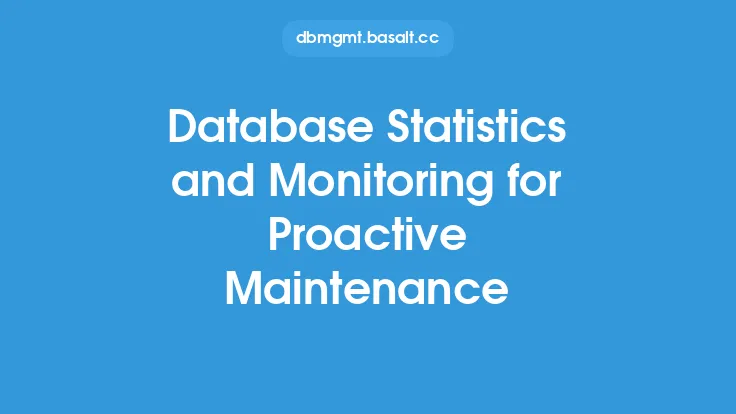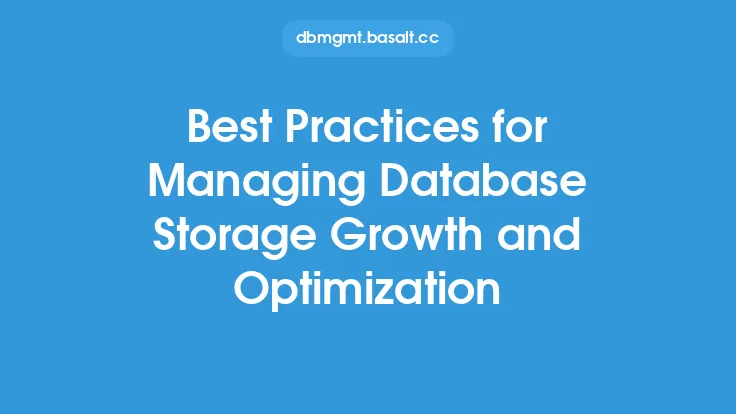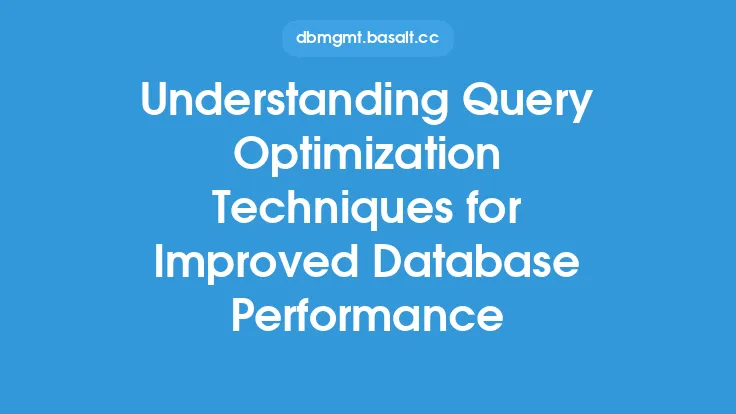Database statistics play a crucial role in maintaining the health and performance of a database. By collecting and analyzing these statistics, database administrators can identify potential issues before they become major problems, optimize database performance, and improve overall system reliability. In this article, we will explore how to leverage database statistics for predictive maintenance and optimization, providing a comprehensive overview of the concepts, techniques, and best practices involved.
Introduction to Database Statistics
Database statistics are numerical values that provide insight into the performance and behavior of a database. These statistics can include metrics such as query execution times, disk usage, memory allocation, and network traffic. By analyzing these statistics, database administrators can identify trends, patterns, and anomalies that may indicate potential issues or areas for improvement. Database statistics can be collected using various tools and techniques, including built-in database management system (DBMS) features, third-party monitoring tools, and custom scripts.
Types of Database Statistics
There are several types of database statistics that can be collected and analyzed, including:
- Query statistics: These statistics provide information about query execution times, query plans, and resource usage. Query statistics can help identify slow-running queries, optimize query performance, and improve overall system responsiveness.
- System statistics: These statistics provide information about system resources such as CPU usage, memory allocation, and disk usage. System statistics can help identify resource bottlenecks, optimize system configuration, and improve overall system performance.
- Storage statistics: These statistics provide information about storage usage, storage performance, and storage configuration. Storage statistics can help identify storage bottlenecks, optimize storage configuration, and improve overall system reliability.
- Network statistics: These statistics provide information about network traffic, network latency, and network configuration. Network statistics can help identify network bottlenecks, optimize network configuration, and improve overall system performance.
Collecting Database Statistics
Collecting database statistics is an essential step in leveraging them for predictive maintenance and optimization. There are several ways to collect database statistics, including:
- Using built-in DBMS features: Most DBMSs provide built-in features for collecting database statistics, such as SQL Server's Dynamic Management Views (DMVs) or Oracle's Automatic Workload Repository (AWR).
- Using third-party monitoring tools: Third-party monitoring tools such as Nagios, SolarWinds, or Datadog can provide detailed database statistics and alerts.
- Using custom scripts: Custom scripts can be written to collect database statistics using programming languages such as Python, Perl, or SQL.
Analyzing Database Statistics
Analyzing database statistics is a critical step in identifying potential issues and areas for improvement. There are several techniques for analyzing database statistics, including:
- Trend analysis: This involves analyzing database statistics over time to identify trends and patterns.
- Threshold analysis: This involves setting thresholds for database statistics and alerting when these thresholds are exceeded.
- Correlation analysis: This involves analyzing the relationships between different database statistics to identify potential causes of issues.
- Regression analysis: This involves using statistical models to predict future database behavior based on historical data.
Predictive Maintenance
Predictive maintenance involves using database statistics to identify potential issues before they become major problems. This can be achieved by:
- Analyzing trends and patterns in database statistics to identify potential issues.
- Setting thresholds for database statistics and alerting when these thresholds are exceeded.
- Using machine learning algorithms to predict future database behavior based on historical data.
- Implementing automated maintenance tasks such as index rebuilding, statistics updating, and backup and recovery.
Optimization
Optimization involves using database statistics to improve database performance and overall system reliability. This can be achieved by:
- Identifying and optimizing slow-running queries.
- Optimizing system configuration to improve resource utilization.
- Optimizing storage configuration to improve storage performance.
- Optimizing network configuration to improve network performance.
- Implementing caching, buffering, and other performance-enhancing techniques.
Best Practices
There are several best practices for leveraging database statistics for predictive maintenance and optimization, including:
- Collecting database statistics regularly and consistently.
- Analyzing database statistics regularly and consistently.
- Setting thresholds for database statistics and alerting when these thresholds are exceeded.
- Implementing automated maintenance tasks and optimization techniques.
- Continuously monitoring and evaluating database performance and overall system reliability.
- Using machine learning algorithms and other advanced techniques to predict future database behavior and optimize database performance.
Conclusion
Leveraging database statistics for predictive maintenance and optimization is a critical aspect of database administration. By collecting and analyzing database statistics, database administrators can identify potential issues before they become major problems, optimize database performance, and improve overall system reliability. By following the concepts, techniques, and best practices outlined in this article, database administrators can ensure that their databases are running at optimal levels, providing improved performance, reliability, and scalability.





